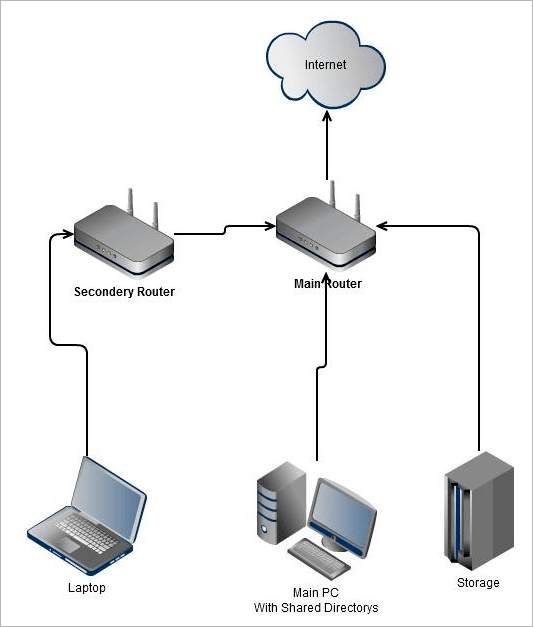How can i acces one of them using a PC connected to the Secondery Router?
Make sure both the routers are properly configured. Each should have a routing table entry for both LANs (192.168.1.x and 192.168.0.x). Such routes can be statically configured or dynamic (using a routing protocol such as RIP).
Properly configured routers will let PCs know what to do when PCs contact the wrong router (typically by issuing ICMP redirects).
Here's a scenario using one router to support two LANs and Internet access
(Internet)
|
+---o-----+ +------+ +------+
|DSL Modem| |switch| |switch|
+---O-----+ +-OOOO-+ +-OOOO-+
| | | | |
+---O--+ | +O-+ | +O-+
|Router| | |PC| | |PC|
+-O-O--+ | +--+ | +--+
| | | |
| `-------------' |
`----------------------------'
|<--------->| |<--------->|
192.168.1.x 192.168.0.x
The router connects both LANs to the INternet and allows all PCs on both LANs to contact each other. The router provides DHCP service to both LANs, That DHCP service tells PCs in each LAN the "gateway address" is the IP-address of the router's interface on that PC's LAN.
Here's a scenario using a second router to link the two LANs
(Internet)
|
+---o-----+ +------+ +------+
|DSL Modem| |switch| |switch|
+---O-----+ +-OOOO-+ +-OOOO-+
| || | | |
+---O--+ || `-. | +O-+
|Router| || | | |PC|
+---O--+ || +O-+ | +--+
| || |PC| |
`-------------'| +--+ |
| |
`----. .----'
| |
+--O-O--+
|Router2|
+-------+
|<--------->|<--------->|
192.168.1.x 192.168.0.x
This is more complicated. Router2 will have a default gateway pointing to the Internet router but will have interfaces in both LANs. If the Internet Router provides DHCP service for the 192.168.1.x LAN, we must make sure that Router2 is configured so it does not also try to provide DHCP service for that LAN. Router 2 should provide DHCP service for 192.168.0.x. Administratively it might be better to make Router 2 provide DHCP service for both LANS and disable DHCP service on the Internet Router - but this may be a less resilient configuration.
If a PC in 192.168.1.x tries to use Router2 to contact the Internet, Router2 will redirect the PC by sending back an ICMP redirect. If a PC in 192.168.1.x tries to use the Internet router to contact the PC in 192.168.0.x, the Internet router will issue a redirect but to do this it has to first be configured to know that router2 is the nearest route to that LAN. I'd typically do this by static config but you could let the routers communicate using RIP or another routing protocol and work it out for themselves.
Update:
You have routers with built-in ethernet switches (pretty common nowadays for small-office/home routers). So you can probably use the "secondary router" as a dumb switch and save yourself a lot of problems.
(Internet)
|
+--o--+ +--------+ +--------+
|DSL | | Router | | Router |
|modem| | .------| | .------|
+--O--+ | |switch| | |Switch|
| +O--OOOO-+ +O--OOOO-+
| | | || | | ||
`------' | || x | ||
| || | |`-----.
,-' |`-----------' | |
| `--. | |
+O-+ | +O-+ +O-+
|PC| +-O-+ |PC| |PC|
+--+ |NAS| +--+ +--+
+---+
|<---------------------------------->|
all 192.168.1.x
I added another PC on the right hand side, as there's no need for a second switch to serve a single PC. In fact with only four PCs/NAS, you probably have enough LAN ports on the main router alone. But perhaps the right-hand-side PCs are in another room and you only have provision for one cable between rooms.

Do you kbow, that DuobleNATing is very bad idea? – Lazy Badger – 2012-03-24T05:29:13.677